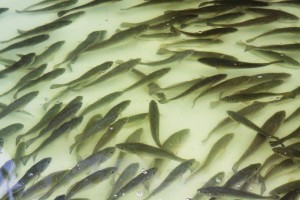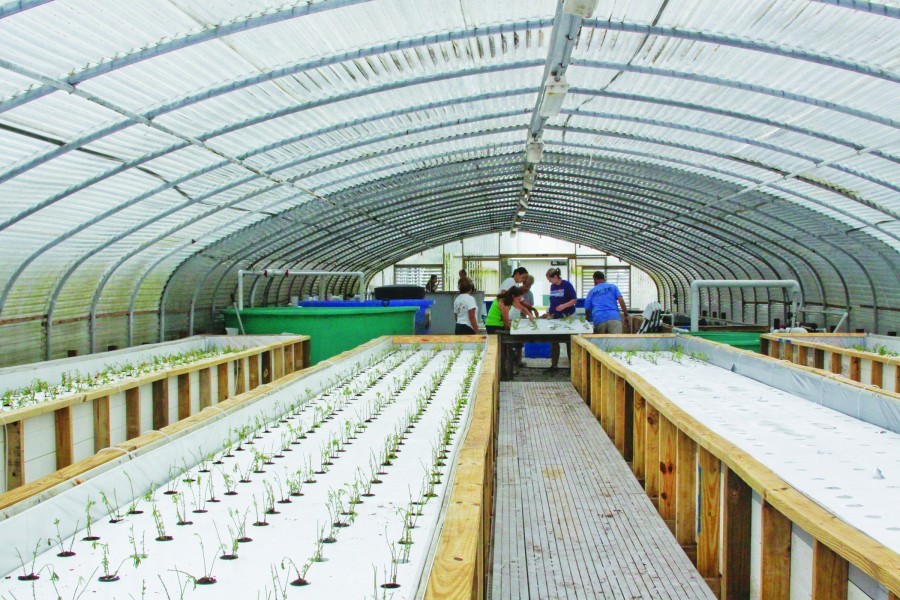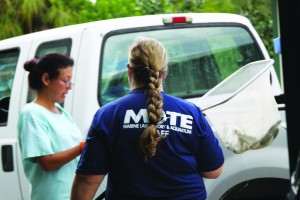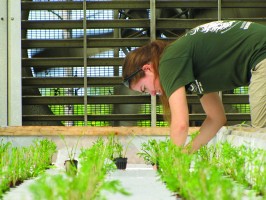From farm-to-fork, sea vegetables and red drum, a saltwater fish species, grown at Mote Aquaculture Park (MAP) using aquaponics – raising seafood while using the wastewater to fertilize salt-loving crops – are making their way into Southwest Florida’s eco-friendly food scene.
Mote Marine Laboratory’s commercial demonstration project in marine aquaponics launched in fall 2014. The project uses eco-friendly technology developed at MAP to farm raise red drum, which is now being sold to restaurants from Sarasota to Tampa, with sea purslane and saltwort, edible sea vegetables that are now being plated in certain local restaurants and sold at the Sarasota Farmers Market.
Dr. Kevan Main, manager of the Marine and Freshwater Aquaculture Research Program at Mote, started this project with the intention of bringing its tasty results to the community and educating people about the importance of locally produced food.
“The goal of this project is to provide opportunities for local, community-based food production,” Main said. “More than 90 percent of the seafood consumed in the United States is imported. It is important that we start thinking about local, sustainable food production.”
The marine aquaponics project uses a closed-loop recirculating system that allows Mote scientists to raise saltwater fish while recycling 100 percent of the water.
The water is first used to raise the red drum, a hearty marine fish that grows well in aquaculture conditions.
Several filters remove the waste produced by the fish and allow bacteria to break down harmful ammonia into other nitrogen-rich compounds used to fertilize the roots of sea purslane and saltwort, which are planted in four raceways in an aquaponics greenhouse. As the nutrients run low, the water is passed through a filtering screen and returned to the fish.
The solid fish waste produced by the aquaponics system is then used to grow wetland plants such as mangroves and salt marsh grasses for coastal restoration projects in partnership with Aquatic Plants of Florida.
The edible plants and the red drum from the system might just end up on your dinner table.
As of July 2015, the red drum has been available to restaurants through seafood wholesalers and the sea purslane has been distributed by the same seafood wholesalers and sold at the Sarasota Farmers Market since January 2015.
“I really wanted to find out what sea vegetables we could provide as local food to local markets, because the availability of vegetables grown from fresh water is decreasing and in the future, we are going to be eating vegetables grown from the sea,” Main said. “I am very excited to be introducing this way of food production to the community.”
The community has enjoyed buying the sea vegetables at the local Sarasota Farmers Market, and chefs focused on local, sustainable foods are key to the project’s success.
In June, local chefs toured MAP to get a taste for Mote’s marine aquaponics project. Katie Sosa, Vice President of Sales at Sammy’s Seafood Inc., organized the tour in an effort to partner with Main’s vision and be a spoke in her wheel of product distribution.
“Sammy’s Seafood is excited to be distributing the fish and the sea vegetables grown at Mote’s aquaculture facility and we’re happy to connect chefs who are passionate about local, sustainable food with Mote,” Sosa said.
Restaurants including Indigenous in Sarasota, Seafood Shack Marina, Bar & Grill in Cortez and Locale in St. Petersburg all use sea purslane that is grown at MAP in their restaurants on a regular basis.
Stephen Phelps, Chef and Owner of Indigenous, has incorporated the sea purslane grown at MAP into his dishes for several months.
“We have a lot of different applications for the sea purslane right now; we’ll tear off the leaves and toss them into sauté dishes or salads. We’ve also started to pickle some of it,” Phelps said.
“And the saltwort has been a big hit, too, Phelps added. “We’ve used it as a very pretty garnish on saltwater fish. We’ve also tempura battered the saltwort and fried it very quickly and that makes it look like coral on top. But we’ve also been pureeing it and emulsifying it. It adds this natural saltiness to everything we are making. So now we’re learning it is not only just this amazing vegetable, but it is also a great spice. It’s a great way to give everything sea salt flavor without using a pinch of sea salt.”
Phelps not only uses the sea vegetables for his restaurant — he has also found a place for them his personal life.
“As a product in the culinary world it has great potential, especially with the incredible health benefits it has,” Phelps said. “I’ve tried it in smoothies. I take the leaves of the vegetables, throw it in with some apple, parsley and kale, which makes for a really nutrient rich smoothie.”
Gerard Jesse, Executive Chef of Seafood Shack, also uses the sea purslane in a couple different dishes in his restaurant on a regular basis, including a vegetable summer roll and local fish sandwich. He said, “The sea purslane has great depth of flavor – you can get the salty flavor without having to add a lot of salt and it’s a good source of vitamin C. Additionally, it’s very important to us to support our local farmers and producers, something we’re committed to.”
As of July 2015, the program has raised about 350 fish and is producing about 160 quarter-pound bunches of sea purslane a month.
“Research is underway to continue improving this sustainable technology to produce sea vegetables and fish for local communities in Florida,” said Dr. Main.








